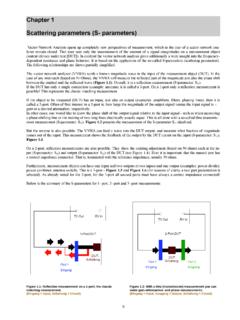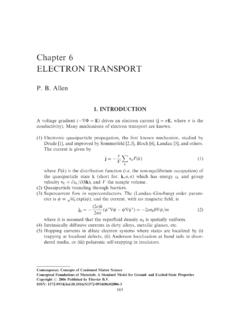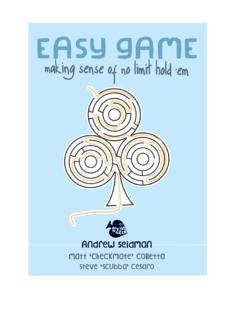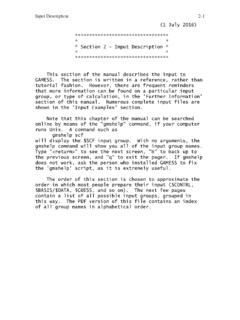Transcription of Chapter 8 Slot Antennas - eetrend.com
1 8-1 Slot AntennasWilliam F. CroswellHarris INTRODUCTION.. SLOTTED-WAVEGUIDE Antennas .. TAPERED AND FLARED SLOT Antennas .. CAVITY-BACKED RECTANGULAR SLOT Antennas .. WAVEGUIDE-FED SLOT Antennas .. SLOT Antennas ON FINITE AND CURVED GROUND PLANES .. SLOT Antennas ON CYLINDERS, CONES, AND SPHERES.. 8-14 Chapter 8 Downloaded from Digital Engineering Library @ McGraw-Hill ( )Copyright 2007 The McGraw-Hill Companies. All rights use is subject to the Terms of Use as given at the website. Source: ANTENNA ENGINEERING HANDBOOK8-2 Chapter EIGHT INTRODUCTIONThis Chapter deals with the radiation characteris-tics of slot Antennas and includes the effects of finite and curved surfaces, dielectric coatings, cavity backing, and single slots fed by wave-guides.
2 The simplest example of such an antenna consists of a rectangular slot cut in an extended thin flat sheet of metal with the slot free to radiate on both sides of this sheet, as shown in Figure 8-1. The slot is excited by a voltage source such as a balanced parallel transmission line connected to the opposite edges of the slot or a coaxial trans-mission line connected to the opposite edges of the slot or a coaxial transmission electric field distribution in the slot can be obtained from the relationship between the slot and complementary wire Antennas , as established by It has been shown that the electric field distribution (magnetic current) in the slot is identical to the electric current distribution on the complementary wire.
3 In the illustrated rectangular slot, the electric field is perpendicular to the long dimension, and its amplitude vanishes at the ends of the electric field is everywhere normal to the surface of the slot antenna except in the region of the slot itself. The theoretical analysis of this configuration shows that the radiation of the currents in the sheet can be deduced directly from the distribution of the electric field in the slot. Consequently, the radiated field of an elementary magnetic moment within the slot boundaries should include the contribution of the electric current flowing on a metal slot-antenna design will often require that the slot be cut in something other than an extended flat sheet surface.
4 Whatever the surface, the electric field will be normal every-where except in the region of the slot. The field due to the electric currents on this metal surface can be deduced from the exciting magnetic currents2 in the slot, just as in the case of the flat metal sheet. This field can be combined with the exciting field so that the result is the total field due to a magnetic current on the given boundary surface. Thus the field of a thin rectangular slot cut in a circular cylinder differs from that of a slot cut in a flat metal sheet because the distribution of electric currents is different for the two general, the slot antenna is not free to radiate on both sides of the surface on which it is cut because one side is either completely enclosed, , the slotted cylinder antenna, or it is desired that the radiation on one side be minimized.
5 In these cases, the influence of the enclosed cavity region on the excitation and impedance of the slot antenna is significant to the antenna SLOTTED-WAVEGUIDE ANTENNASS lotted-waveguide Antennas have significant applications in the areas of missile, spacecraft, and airborne radar. Broad-wall slotted-waveguide Antennas have been studied extensively. Oliner,3 following research by Stevenson,4 has derived equivalent circuit representations for this type of antenna. These circuits allow accurate computation of the normalized con-ductance, susceptance, resistance, reactance, and resonant frequency of broad-wall slots.
6 The types of slots and the equivalent networks are given in Chapter broad-wall slots also have been characterized thoroughly. Bailey5 has summarized significant findings. The general problem discussed by Bailey extends Oliner s work to include the effects on broad-wall slots radiating into a multilayer dielectric medium. The basic effect that occurs by adding a dielectric layer over slots in a waveguide is to FIGURE 8-1 Rectangular slotDownloaded from Digital Engineering Library @ McGraw-Hill ( )Copyright 2007 The McGraw-Hill Companies. All rights use is subject to the Terms of Use as given at the website.
7 Slot Antennas SLOT Antennas 8-3produce a downward shift in resonant frequency. For dielectric layers whose thickness is greater than , where =0,the approximate resonant shift is given in Figure 8-2, where l is the wavelength in the dielectric, l0 is the wavelength in free space, and e is the dielectric constant. Further analysis, and comparison with experimental data, is also avail-able, as shown in Figure 8-2 Resonant length of a dielectric-covered shunt slot in WR-90 (RG 52/U) wave-guide (b1 = in, t = in, a = in, b = in) (after Bailey5 IEEE 1970)FIGURE 8-3 Resonant conductance (a) and resonant length (b) versus layer thickness, er = (after Katehi6 IEEE 1990)Downloaded from Digital Engineering Library @ McGraw-Hill ( )Copyright 2007 The McGraw-Hill Companies.
8 All rights use is subject to the Terms of Use as given at the website. Slot Antennas8-4 Chapter EIGHT The typical polarization of most slotted-waveguide Antennas is linear. However, several slotted-waveguide elements have been designed that produce circular , TAPERED AND FLARED SLOT ANTENNAST apered slot Antennas (TSAs) were first introduced in the late 1950s. It was then that Eberle et al9 produced a waveguide-fed, flared slot antenna for use in aircraft skins where conventional Antennas could not be easily integrated. Gibson10 then developed the strip-line-fed, exponentially tapered slot antenna, which he called the Vivaldi aerial.
9 His design was the first recognized TSA that showed symmetric E- and H-plane beamwidths, low sidelobes, and moderate then, with the increased interest in MIC (microwave integrated circuit) anten-nas for applications ranging from satellite communications to remote sensing, tapered slot Antennas have been studied extensively, both empirically and theoretically. In general, the performance you can expect to achieve from a typical TSA includes Broadband operation Moderate gain Low sidelobesThese radiation characteristics make TSAs suitable elements for reflector feeds or as stand-alone current form of a typical TSA is planar in nature, etched on a thin, low-dielectric-constant microwave substrate, and fed by a stripline, finline, or slotline configuration, as shown in Figure 8-4.
10 As a result of the typical substrates used in TSA designs, it is impor-tant to consider the possibility of the feedline itself radiating or coupling with the antenna element. Work at Harris Corporation has addressed this problem and has resulted in a bilat-eral stripline feed as one solution (see Figure 8-5).TSAs are a type of traveling-wave antenna. Their operation is based on a traveling wave propagating along the surface of the antenna taper with a phase velocity less than the speed of Under this condition, endfire radiation results. Zucker reviews properties of traveling-wave Antennas in Chapter 8-4 Three different types of endfire tapered slot anten-nas along with a dielectric-rod antenna shown for comparison (after Yngvesson et al11,12 IEEE 1985 and IEEE 1989)Downloaded from Digital Engineering Library @ McGraw-Hill ( )Copyright 2007 The McGraw-Hill Companies.






